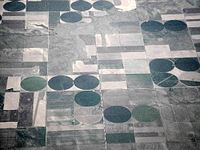
Photo from wikipedia
Milk yield and milk composition of Kalahari red goat and the performance of their kids in the humid zone were studied. Data were collected from twenty six (26) Kalahari red… Click to show full abstract
Milk yield and milk composition of Kalahari red goat and the performance of their kids in the humid zone were studied. Data were collected from twenty six (26) Kalahari red goats over a period of 119 days. Stage of lactation was a significant source of variation for milk offtake (p 0.05). Peak milk offtake was observed at weaning (42 weeks of lactation). Littersize had significantly (p<0.05) different weight with the single born kids being heavier than twin born kids. Litter size did not influence dam’s weight, milk offtake and milk yield. Sex of kids significantly (p<0.05) affected dam’s weight, milk yield and kids weight but had no effect on milk offtake. Kids that were single (11.98 kg) had higher weights than kids that were twins (8.8 kg). The change in kids’ weight on weekly basis varied significantly (p<0.05). Kids’ weight increased with the week of lactation (p<0.05) till the 12th week. Weight of kids was as high as 15.35 kg at the 17th week of lactation with the average of 10.44 kg. There was a significant difference in kids’ sex (p<0.05) with male kids having higher weights (13.22 kg) when compared to the female kids (11.28 kg). The average milk components (%) were 5.16; 7.58; 4.99; 0.54; 81.15; 11.27 and 6.47 for protein, fat, lactose, ash, moisture, total solids, solid-not-fat and pH respectively. Correlation between milk yield and dams weight (r= 0.31) was significant and positive in Kalahari goats but negative correlations were observed between milk yield and kids’ weight (r= -0.45) in this breed. Kids’ weight was higher in estimating milk yield in Kalahari does with a coefficient of determination of 45%. Therefore, the lengthy lactation, high milk yield and quality milk component of Kalahari goats suggest that this goat breed could be adopted as a dairy animal in the humid zone of Nigeria. Great reliability can be achieved in the prediction of milk yield using kids’ weight.
Journal Title: Archivos De Zootecnia
Year Published: 2017
Link to full text (if available)
Share on Social Media: Sign Up to like & get
recommendations!